数据结构与算法--图
1 图的基本概念
图(Graph) 是由一个顶点集V和一个弧集E构成的网状数据结构,记作
G
=
(
V
,
E
)
G = (V ,E)
G=(V,E) 在图中,数据元素通常称作顶点(Vertex),V是顶点的有穷非空集合;VR是两个顶点之间的关系的集合
线性表可以为空表,树可以是空树,但是图不可以为空,即图一定是非空集
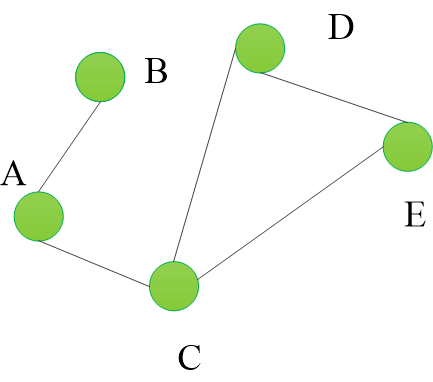
2 无向图和有向图
在一个图中,如果任意两个顶点构成的偶对(a,b)属于E是无序的,即顶点之间的连线是没有方向的,则称该图为无向图。
在一个图中,如果任意两个顶点构成的偶对(a,b)属于E是有序的,即顶点之间的连线是有方向的,则称为有向图
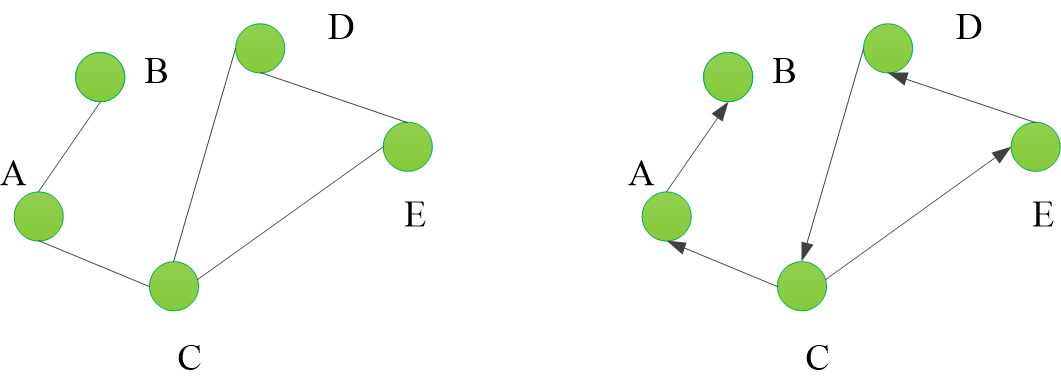
3 图相关的关键术语
顶点 : 图中的节点
弧 : 有向图 v为起点 w为终点 <v,w>表示v到w的一条弧
边 : 无向图 有<v,w>就有<w,v>
权 : 可以理解成边的长度
顶点的度 : 和该顶点相关联的边的数目 度 = 入度 + 出度
顶点的入度 : 该顶点为终点
顶点的出度 : 该顶点为起点
路径 : 从一个顶点到另一个顶点的路径
连通图 : 任意两个顶点都是连通的
4 图的相关性质
设 n为图中的节点数
e为边或弧的数目 则有如下性质
-
在无向图中
e的取值范围是0 ~ n(n-1)/2
在无向图中,如果有e = n(n-1)/2,则为完全图
-
在有向图中
e的取值范围是n(n-1)
在有向图中,如有n(n-1)条弧,则称为有向完全图
5 图的存储
邻接表法 邻接矩阵法
图
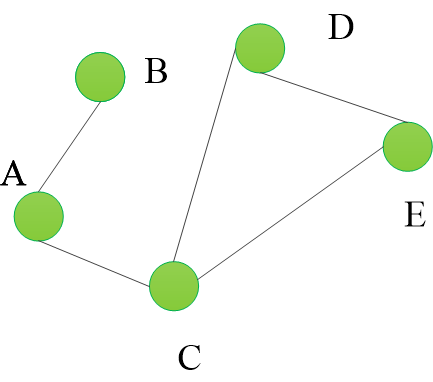
4.1 邻接表法
使用链表来表示图的连接关系,对于每个顶点,使用链表存储与其相邻的顶点,邻接表的优点是对于稀疏图而言,存储空间较小;同时可以快速遍历每一个顶点的邻接顶点,但是查找两个顶点之间是否存在边的时间复杂度为
O
(
k
)
O(k)
O(k),其中k是相邻顶点的数量
特点 :
-
在邻接表中,给定一顶点就很容易地找到它所有邻边
-
在有向图的邻接表中,求一个给定顶点的出度只需计算其邻接表中的结点个数即可,但求某顶点的入度,则需要遍历全部的邻接表
-
图的邻接表表示并不唯一,因为各边表结点的顺序是任意的
-
邻接表便于增加和删除节点,便于统计边数
邻接表属于链式存储,但邻接表的表头属于顺序存储结构
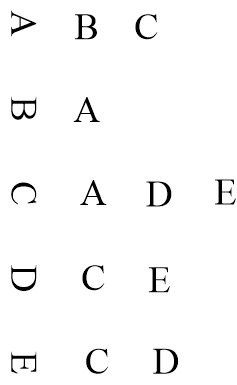
4.2 邻接矩阵法
使用一个二维数组来表示图的连接关系,对于n个顶点的无向图,使用 n * n的矩阵表示 如果两个顶点 i和j之间存在边,则在矩阵中 (i,j) 和 (j,i)的值为1,否则为0,(i,j) 位置的值表示从顶点i到顶点j的边
邻接矩阵的优势是查找两个顶点之间是否存在边的时间复杂度为 O ( n ) O(n) O(n)
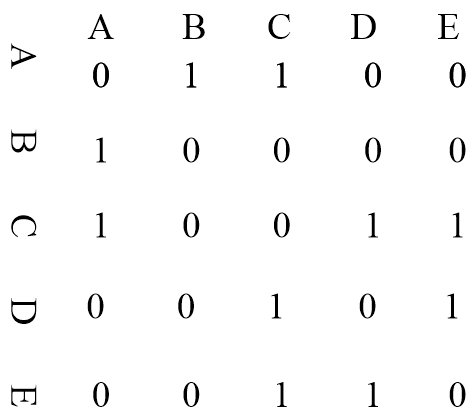
无向图的邻接矩阵一定是对称矩阵
6 图的代码表示
顶点
public class Node {
// 点上的值
public int value;
// 一个点的入度 有多少条边指向自己
public int in;
// 一个点的出度 一个点指向其它点的边个数
public int out;
// 从自己出发直接相邻的点
public ArrayList<Node> nexts;
// 属于这个节点的边有哪些
public ArrayList<Edge> edges;
public Node(int value){
this.value = value;
in = 0;
out = 0;
nexts = new ArrayList<>();
edges = new ArrayList<>();
}
}
边
public class Edge {
public int weight;// 权值可以表示距离
public Node from;//
public Node to;//
public Edge(int weight, Node from, Node to) {
this.weight = weight;
this.from = from;
this.to = to;
}
}
图
/**
* 图的表示方式 邻接图 邻接矩阵
* @author Mrchao
* @version 1.0.0
* @date 2023-07-10
*/
public class Graph {
// 点集 key 点的编号 Node实际的点
public HashMap<Integer,Node> nodes;
// 边集
public HashSet<Edge> edges;
public Graph(){
nodes = new HashMap<>();
edges = new HashSet<>();
}
}
7 图的构建
假如有一个N * 3的数组,用于表示一个城市到另一个城市的距离,第一列表示出发城市,第二列表示到达城市,第三列表示两个城市的距离,如图所示

例如要构建如图所示的图:
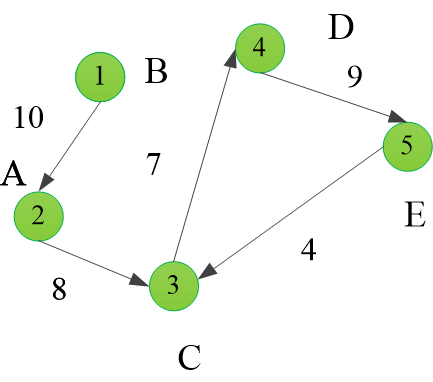
public static void main(String[] args) {
int[][] cityMatrix = new int[][]{
{1,2,10},
{2,3,8},
{3,4,7},
{4,5,9},
{5,3,4}
};
createGraph(cityMatrix);
}
/**
* matrix[i][0] 起始城市
* matrix[i][1] 终止城市
* matrix[i][2] 两个城市之间的距离
*
* @param matrix
* @return
*/
public static Graph createGraph(int[][] matrix) {
Graph graph = new Graph();
for (int i = 0; i < matrix.length;++i){
// 起始城市的编号
int from = matrix[i][0];
// 终止城市的编号
int to = matrix[i][1];
// 两个城市之间的距离
int weight = matrix[i][2];
// 如果图中没有包含这两个城市,则将这两个城市当做点加入到图中
if (!graph.nodes.containsKey(from)){
// key点的编号 value实际的点
graph.nodes.put(from,new Node(from));
}
if (!graph.nodes.containsKey(to)){
graph.nodes.put(to,new Node(to));
}
Node fromNode = graph.nodes.get(from);
Node toNode = graph.nodes.get(to);
// 创建边
Edge edge = new Edge(weight,fromNode,toNode);
// 起始城市的邻居是toNode
fromNode.nexts.add(toNode);
// 起始城市的边
fromNode.edges.add(edge);
// 终止城市的边
toNode.edges.add(edge);
// 起始城市的出度+1
fromNode.out++;
//终止城市的入度+1
toNode.in++;
// 边加入图中
graph.edges.add(edge);
}
return graph;
}
8 图的宽度优先遍历
利用队列实现
- 从源节点开始,依次按照宽度进队列,然后弹出
- 每次弹出一个节点,把该节点所有没有进过队列的邻接节点放入队列
- 直到队列为空
/**
* 从源节点出发进行宽度优先遍历
* @param node
*/
public static void broadFirstTraversal(Node node){
if (node == null){
return;
}
Queue<Node> queue = new LinkedList<>();
// 为了保证放入队列的节点不重复
HashSet<Node> set = new HashSet<>();
queue.add(node);
set.add(node);
while (!queue.isEmpty()){
Node cur = queue.poll();
System.out.println(cur.val);
//遍历当前点的所有邻接节点
for (Node next : cur.nexts) {
if (!set.contains(next)){
queue.add(next);
set.add(next);
}
}
}
}
9 图的深度优先遍历
- 利用栈实现
- 从源节点开始把节点按照深度放入栈,然后弹出
- 每次弹出一个节点,把该节点所有没有进过栈的邻节点放入栈
- 直到栈变空
public class DFSTest {
public static void main(String[] args) {
int[][] cityMatrix = new int[][]{
{1,2,10},
{2,3,8},
{3,4,7},
{4,5,9},
{5,3,4},
{1,3,20},
{1,5,70}
};
Graph graph = CreGraphTest.createGraph(cityMatrix);
depthFirstTraversal(graph.nodes.get(1));
}
/**
*
* @param node 图中的源节点
*/
public static void depthFirstTraversal(Node node){
if (node == null){
return;
}
// 深度优先遍历 使用栈
Stack<Node> stack = new Stack<>();
HashSet<Node> set = new HashSet<>();
stack.push(node);
set.add(node);
System.out.println(node.val);
while (!stack.isEmpty()){
Node cur = stack.pop();
for (Node next : cur.nexts) {
// 没有遍历过将cur压入到栈中
if (!set.contains(next)){
// 栈中存放的是每次按深度优先遍历的顶点
stack.push(cur);
stack.push(next);
set.add(next);
System.out.println(next.val);
break;
}
}
}
}
}
10 拓扑排序算法
要求 : 有向图,且有入度为0的节点,且没有环
比如在编译一个模板时,有如下依赖关系
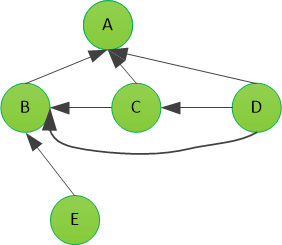
E–>D–>D–>B–>A
在比如如下的图:

依次找到入度为0的点,擦掉它的影响
public class TopologySortTest {
public static void main(String[] args) {
Integer[][] matrix = new Integer[][]{
{1,2,0},
{1,3,0},
{2,3,0},
{2,4,0},
{3,4,0},
{4,5,0}
};
Graph graph = GraphGene.createGraph(matrix);
List<Node> nodes = topologySort(graph);
for(Node node :nodes){
System.out.print(node.value + " ");
}
System.out.println();
}
public static List<Node> topologySort(Graph graph){
Map<Node,Integer> inMap = new HashMap<>();// key图中的某个节点 value 剩余的入度
// 只有入度为0的点 才能进这个队列
Queue<Node> zeroInQueue = new LinkedList<>();
//遍历图中的每一个顶点 遇到入度为0的顶点则放入到0入度队里
for (Node node : graph.nodes.values()) {
inMap.put(node,node.in);
if(node.in == 0){
zeroInQueue.add(node);
}
}
// 拓扑排序的结果
List<Node> retList = new ArrayList<>();
while (!zeroInQueue.isEmpty()){
Node cur = zeroInQueue.poll();
retList.add(cur);
// 遍历此顶点所有的邻接节点
for (Node next : cur.nexts){
// 将邻接节点的入度减 1
inMap.put(next,inMap.get(next) - 1);
// 入度为 0 则加入0入度队列
if (inMap.get(next) == 0){
zeroInQueue.add(next);
}
}
}
return retList;
}
}
11 kruskal算法(从边出发)
适用范围 : 要求无向图
生成最小生成树,保证连通,连通之后所有边的权值之和是最小的
从图的最小的边开始,依次加入,如果不会形成环,则加入,否则不加入
如何在加入边的时候,判断是否会形成环,使用并查集
集合的查询和集合的合并,使用并查集
public class KruskalTest {
public static class MySets {
// key 每个点 value每个点对应的集合
public HashMap<Node, List<Node>> setMap = new HashMap<>();
public MySets(List<Node> nodes) {
for (Node cur : nodes) {
// 最开始 所有的点所在的集合只有自己
List<Node> set = new ArrayList<>();
set.add(cur);
setMap.put(cur, set);
}
}
/**
* 判断 from点和to点是否在同一个集合里
*
* @param from
* @param to
* @return
*/
public boolean isSameSet(Node from, Node to) {
List<Node> fromSet = setMap.get(from);
List<Node> toSet = setMap.get(to);
// 直接比较内存地址是否一致
return fromSet == toSet;
}
/**
* from节点所在的集合和to所在的集合合并
*
* @param from
* @param to
*/
public void union(Node from, Node to) {
List<Node> fromSet = setMap.get(from);
List<Node> toSet = setMap.get(to);
// 把to集合中的元素加入到from中
for (Node toNode : toSet) {
fromSet.add(toNode);
setMap.put(toNode, fromSet);
}
}
}
public static class EdgeComparator implements Comparator<Edge> {
@Override
public int compare(Edge o1, Edge o2) {
return o1.weight - o2.weight;
}
}
/**
* 生成最小生成树
*
* @param graph
* @return
*/
public static Set<Edge> kruskalMST(Graph graph) {
List<Node> nodeList = new ArrayList<>();
nodeList.addAll(graph.nodes.values());
MySets mySets = new MySets(nodeList);
PriorityQueue<Edge> priorityQueue = new PriorityQueue<>(new EdgeComparator());
// 把图中所有的边加入到队列中
for (Edge edge : graph.edges) {
priorityQueue.add(edge);
}
Set<Edge> retSet = new HashSet<>();
while (!priorityQueue.isEmpty()) {
Edge edge = priorityQueue.poll();
// 判断当前边的from点和to点是否在一个集合里
if (!mySets.isSameSet(edge.from, edge.to)) {
retSet.add(edge);
// 合并当前边的顶点
mySets.union(edge.from, edge.to);
}
}
return retSet;
}
}
12 prime 算法(从点出发)
适用于无向图
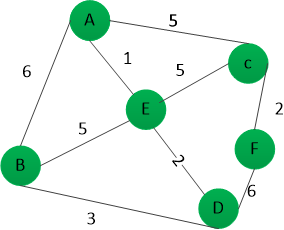
-
从图中选择一个起始节点,如果没有被处理过,则将该节点加入到已处理的集合中
-
遍历此节点所有的边,加入到优先级队里(优先级队里按边的权值大小排序)
-
从优先级队列中弹出一条边,找到此条边的
to节点,如果to节点未处理过,则将to节点加入到已处理过的节点中,此条边加入到结果集中,遍历图节点的所有邻边,加入到优先级队列,循环往复,直到队里为空
public class PrimeMSTTest {
public static class EdgeComparator implements Comparator<Edge> {
@Override
public int compare(Edge o1, Edge o2) {
return o1.weight - o2.weight;
}
}
/**
* 从边出发 生成最小生成树
*
* @param graph
* @return
*/
public static Set<Edge> primMST(Graph graph) {
Set<Edge> retSet = new HashSet<>();
if (graph == null) {
return retSet;
}
// 存放点解锁的边
PriorityQueue<Edge> priorityQueue = new PriorityQueue<>(new EdgeComparator());
// 存放已经考察过的点
Set<Node> nodeSet = new HashSet<>();
// 从任意一个点出发
for (Node node : graph.nodes.values()) {
if (!nodeSet.contains(node)) {
nodeSet.add(node);
// 把该点解锁的边加入到队列
for (Edge edge : node.edges) {
priorityQueue.add(edge);
}
while (!priorityQueue.isEmpty()) {
Edge edge = priorityQueue.poll();
Node toNode = edge.to;
if (!nodeSet.contains(toNode)) {
// 被解锁边的节点被考察过
nodeSet.add(toNode);
retSet.add(edge);
for (Edge nextEdge : toNode.edges) {
priorityQueue.add(nextEdge);
}
}
}
}
}
return retSet;
}
}
13 dijkstras算法
适用范围 : 不能有累加和为负数的环
单元最短路径算法
规定一个出发点,到后续每一个点最短距离是多少
整体步骤 :
-
创建一张
Hash表,存放处理过程中到给定节点最短的距离,创建一个Set存放已经 被处理过的节点 -
从Hash表中找到一个未被处理过的距离给定节点最短的节点
-
遍历2中得到的节点所有的边,处理该点到每条边的
toNode的距离 -
循环整个过程
比如处理如图所示的图
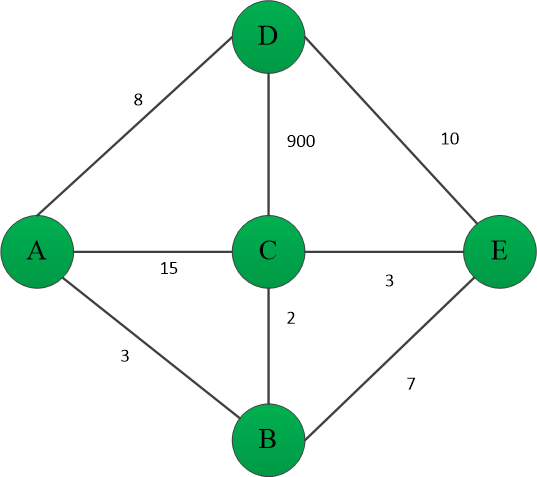
代码如下 :
public class DijkstraTest {
public static void main(String[] args) {
Integer[][] graphArr = new Integer[][]
{
{1, 2, 3},
{1, 3, 15},
{1, 4, 8},
{2, 3, 2},
{2, 5, 7},
{3, 4, 900},
{3, 5, 3},
{4, 5, 10}
};
Graph graph = GraphGene.createGraph(graphArr);
Node node = graph.nodes.get(1);
Map<Node, Integer> nodeIntegerMap = dijkstra(node);
for (Map.Entry<Node, Integer> entry : nodeIntegerMap.entrySet()) {
System.out.println("node : " + entry.getKey().value + " is " + entry.getValue());
}
}
public static Map<Node, Integer> dijkstra(Node head) {
// key 图中的每一个节点
// value 给定的节点到 图中每个节点的最小距离
Map<Node, Integer> distanceMap = new HashMap<>();
distanceMap.put(head, 0);
Set<Node> selectNodes = new HashSet<>();
Node node = getMinDistanceAndUnselectedNode(distanceMap, selectNodes);
while (node != null) {
for (Edge edge : node.edges) {
Node toNode = edge.to;
//该点的边没有被处理,则更新
if (!distanceMap.containsKey(toNode)) {
distanceMap.put(toNode, distanceMap.get(node) + edge.weight);
} else {
// 该点的邻接节点到给定的距离 和 当前点到给定点距离+当前点到 邻接点的距离
// 这两个距离 谁小就取谁
distanceMap.put(toNode, Math.min(distanceMap.get(toNode),
distanceMap.get(node) + edge.weight));
}
}
selectNodes.add(node);
node = getMinDistanceAndUnselectedNode(distanceMap, selectNodes);
}
return distanceMap;
}
/**
* 从 distanceMap 选择一个距离最小的没有被考察过的节点
*
* @param distanceMap
* @param touchedNode
* @return
*/
public static Node getMinDistanceAndUnselectedNode(Map<Node, Integer> distanceMap,
Set<Node> touchedNode) {
Integer minDistance = Integer.MAX_VALUE;
Node minNode = null;
Set<Map.Entry<Node, Integer>> entrySet = distanceMap.entrySet();
for (Map.Entry<Node, Integer> entry : entrySet) {
Node node = entry.getKey();
Integer distance = entry.getValue();
if (!touchedNode.contains(node) && distance < minDistance) {
minDistance = distance;
minNode = node;
}
}
return minNode;
}
}
可以把遍历找map中最小距离的过程改成小顶堆,具体代码如下 :
public static class NodeRecord {
public Node node; // 节点
public Integer distance; // 节点到指定节点的距离
public NodeRecord(Node node, Integer distance) {
this.node = node;
this.distance = distance;
}
}
/* 自定义堆 */
public static class NodeHeap {
private Node[] nodes;// 堆中的元素
private Map<Node, Integer> heapIndexMap;//key 堆中的节点 value 堆中的节点的索引
private Map<Node, Integer> distanceMap;// 每个点到指定点的距离
private Integer size;// 堆中元素的个数
public NodeHeap(int size) {
this.size = size;
heapIndexMap = new HashMap<>();
distanceMap = new HashMap<>();
}
public boolean isEmpty() {
return this.size == 0;
}
public void add_update_ignore(Node node, Integer distance) {
if (inHeap(node)) {
distanceMap.put(node, Math.min(distanceMap.get(node), distance));
insertHeapify(heapIndexMap.get(node));
}
if (!isEntered(node)) {
nodes[size] = node;
heapIndexMap.put(node, size);
distanceMap.put(node, distance);
insertHeapify(size++);
}
}
/**
* 弹出堆顶节点
*
* @return
*/
public NodeRecord pop() {
NodeRecord nodeRecord = new NodeRecord(nodes[0], distanceMap.get(nodes[0]));
swap(0, size - 1);
heapIndexMap.put(nodes[size - 1], -1);
distanceMap.remove(nodes[size - 1]);
nodes[size - 1] = null;
heapify(0, --size);
return nodeRecord;
}
/**
* 调整index位置的节点 使堆还是小根堆
*
* @param index
*/
private void insertHeapify(Integer index) {
while (distanceMap.get(nodes[index]) < distanceMap.get(nodes[(index - 1) / 2])) {
swap(index, (index - 1) / 2);
index = (index - 1) / 2;
}
}
/**
* 把index位置的节点向下调整 使堆还是小根堆
*
* @param index
* @param size
*/
private void heapify(Integer index, Integer size) {
int left = 2 * index + 1;
while (left < size) {
// 求左子节点和右子节点较小值的索引
int smallerIndex = left + 1 < size && distanceMap.get(left + 1) < distanceMap.get(left)
? left + 1 : left;
smallerIndex = distanceMap.get(smallerIndex) < distanceMap.get(index) ? smallerIndex : index;
if (smallerIndex == index) {
break;
}
swap(smallerIndex, index);
index = smallerIndex;
left = 2 * index + 1;
}
}
/**
* 判断 node 是否进入过堆中
*
* @param node
* @return
*/
private boolean isEntered(Node node) {
return heapIndexMap.containsKey(node);
}
private boolean inHeap(Node node) {
// 进来过堆 在数组中
return isEntered(node) && heapIndexMap.get(node) != -1;
}
/**
* 堆上的两个元素调整位置
*
* @param index1
* @param index2
*/
private void swap(Integer index1, Integer index2) {
// 表中节点的位置互换
heapIndexMap.put(nodes[index1], index2);
heapIndexMap.put(nodes[index2], index2);
Node temp = nodes[index1];
nodes[index1] = nodes[index2];
nodes[index2] = temp;
}
}
/**
* @param head 指定的节点
* @param size 图中节点的个数
* @return
*/
public static HashMap<Node, Integer> dijkstra(Node head, int size) {
HashMap<Node, Integer> retMap = new HashMap<>();
NodeHeap nodeHeap = new NodeHeap(size);
nodeHeap.add_update_ignore(head, 0);
while (!nodeHeap.isEmpty()) {
NodeRecord nodeRecord = nodeHeap.pop();
Node curNode = nodeRecord.node;
Integer distance = nodeRecord.distance;
for (Edge edge : curNode.edges) {
nodeHeap.add_update_ignore(edge.to, distance + edge.weight);
}
retMap.put(curNode, distance);
}
return retMap;
}






















 525
525

 被折叠的 条评论
为什么被折叠?
被折叠的 条评论
为什么被折叠?








